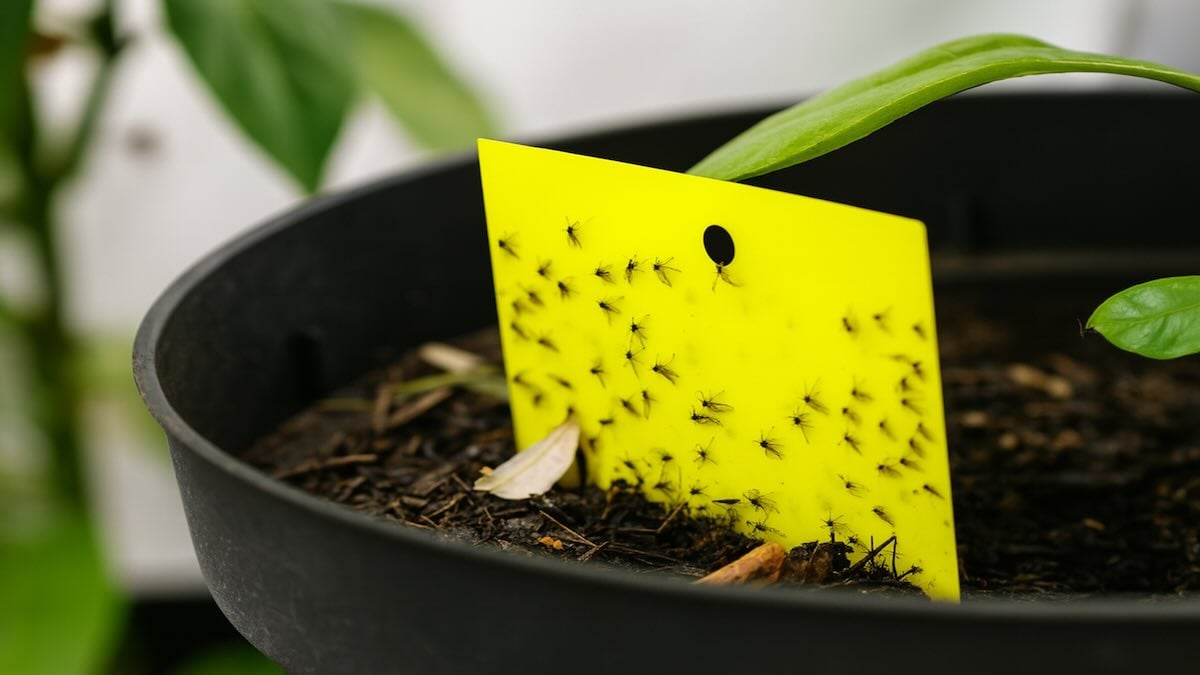Moist soil turns into a runway for tiny flyers that stunt growth and test your patience. They appear fast, linger around pots, and weaken roots while you water again and again. Tackle the problem at its source, because quick fixes never hold. This guide shows how to break the cycle, protect roots, and restore calm. It also explains where midges come from, why they stay, and how to keep them out for good.
What potting soil gnats are and how they spread
Fungus gnats are small, dark flies that hover over potting mix and windowsills. Adults live short lives yet cause trouble as they search damp soil for places to breed. Eggs hatch below the surface, larvae feed on fungi, and plants suffer stress.
The cycle moves fast. Under the right conditions, a single adult can lay up to 300 eggs at once, so numbers surge quickly. You often see adults when you water, because vibration sends them up in a cloud.
Larvae stay hidden, nibbling roots and slowing growth. Because they love constant moisture, your routine may be helping them. Break the moisture pattern, and you starve the colony. Use light, airflow, and patience, since chemicals alone rarely solve the root cause. When you treat the soil and improve habits together, midges lose ground and plants rebound.
Why midges explode in planters: water, soil, and new arrivals
Overwatering is the main driver. Wet mix creates a buffet of fungi and algae, so larvae thrive and adults return to lay more eggs.
Poor drainage makes it worse. Containers without clear drainage holes trap water, and heavy media hold it longer than roots can handle. Swap to a well-draining blend with perlite or bark so air moves between particles.
Another trigger hides in plain sight: new pots, cuttings, or bags of soil that arrive already infested. Quarantine fresh purchases for a short period and check for movement on the soil surface. Look beneath saucers and along rims, because adults rest there between flights.
Simple checks before plants join your shelf stop problems before they start. Clean tools and trays as you go, since bits of damp mix attract flies. With these basics in place, most outbreaks never happen.
Targeted steps that cut numbers fast and block the next wave
Let the top layer of soil dry between waterings. Dryness interrupts larvae and reduces fungus growth, so adults stop choosing that pot. Water less often, and water deeply when you do, so roots grow down and stay strong.
Then trap the flyers. Yellow sticky cards catch adults as they wander, which lowers egg-laying and gives instant feedback. Place cards near the canopy and just above the soil line.
For larvae, treat the medium. A gentle soil drench with hydrogen peroxide solution or neem oil reaches pockets that cards cannot. These treatments are plant-safe when used as directed, and they pair well with better watering habits. Because midges rely on damp, low-oxygen pockets, your goal is simple: make the surface unfriendly, keep air moving, and deny them the wet layer they need to feed and breed.
Extra armor for stubborn cases: sand, powder barriers, and tiny allies
Topdress with a thin layer of horticultural sand or diatomaceous earth. This dries quickly and forms a rough surface, so larvae struggle to reach air. It also discourages adults from laying eggs, since the texture signals poor conditions. Refresh the layer after watering to keep it effective.
For heavy infestations, enlist beneficial nematodes. These microscopic worms hunt larvae in the mix and reduce numbers quietly over time. They do not harm plants, pets, or people. Use them alongside traps and careful watering for a one-two punch.
Keep the routine steady, because mixed signals invite a rebound. Avoid drastic chemical sprays indoors; they target adults but miss the soil stage that drives the problem. With the surface sealed, larvae controlled, and adults trapped, the life cycle finally breaks.
Long-term care that prevents return visits and keeps growth on track
Healthy routines lock in results. Choose a fast-draining mix, match pot size to root mass, and empty saucers after each drink. Water when the top inch feels dry, not by the calendar. Rotate pots toward light so the surface dries evenly.
Improve airflow around leaves and keep surfaces clean; algae and decaying bits feed fungi below. Inspect new plants at the store and again at home. A short quarantine protects the rest of your collection.
Repot tired mixes that compact and hold water too long. Wipe down shelves and rinse trays so residue does not build. Use bottom watering when it suits the plant, then drain well. Keep a few sticky cards in high-traffic spots as early warning. With these simple habits, midges stop finding a home, roots stay strong, and leaves show the difference.
Lasting habits that keep pests away and safeguard growth
Small, steady changes beat quick sprays and guesswork. Drying cycles, clean tools, and better mixes remove what pests need and keep roots firm. Traps and gentle drenches then handle stragglers without harsh fallout.
When you pair checks on new arrivals with routine airflow and light, the cycle stays broken. That way, even if midges wander in, they find nothing to fuel the next wave.
